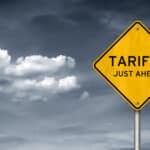How is that deglobalization working out for you?
As companies continue their drive to find alternative sources to Chinese manufacturing, many are discovering that despite moving final assembly to Vietnam, Brazil, Mexico, etc., 90% of their supply chain still relies on China. Companies are going to have to re-engineer their entire supply chains – raw materials, parts, everything – to truly diversify their risk and achieve optionality.
Sure, Vietnam now makes your T-shirts, Brazil your refrigerators, Mexico your electrical equipment.
But Vietnam’s supply for fabric, dyes and buttons starts in China. Brazil buys refrigerator compressors from China. The metals in that electrical equipment? You guessed it – they come to Mexico from China. So only $1 million from that $10 million in spending really moved out of China.
That’s a single-source supply chain, not even close to optionality – and certainly not what your executive team has in mind. After all, if global instability and trade wars trigger China into cutting off your enterprise’s key raw materials, your final assembly will grind to a halt until you source additional raw materials and parts.
Completely re-engineering supply chains will not be an overnight process, as I’ve explained several times before.
Where to go? India is a good place to start, and many, from Apple to Boeing to others, are already making the move. The country has resources, a young population and is a Western-style parliamentary democracy. But there are still a lot of headwinds, like poor labor productivity, poor physical infrastructure and potentially slow decision-making because of too many stakeholders.
Still, I think long term India has the best chance of replacing China, and, as this report claims, the next decade could belong to what recently became the world’s most populous country, according to the United Nations.
But again, that’s a single source. So, I would advise broadening your scope. Include the ASEAN countries. Beyond the aforementioned Vietnam, Thailand, Malaysia, Indonesia and the Philippines have strong manufacturing sectors.
Central and South America already produce a lot of apparel, and revenue is expected to continue growing. Brazilian furniture and footwear makers, in particular, have capacity to spare. From natural and mineral resources to the construction market and automotive industry, African nations have potential as well.
Your future supply chains (notice the multiple there) could source some manufacturing in Africa, send some raw materials from Africa to manufacturers in South America, and include operations in the Philippines, Singapore and Malaysia.
As you can see from above, the term deglobalization is not correct. I’ve used the term global reorientation before, but you could also call it globalization minus China.
Either way, the next decade of global supply chain re-engineering promises to be a wild ride, similar in scale and scope to the previous three decades that transformed China from a manufacturing backwater to a powerhouse. Only this time, there will be many winners, not just one country.
Jim Tompkins, Chairman of Tompkins Ventures, is an international authority on designing and implementing end-to-end supply chains. Over five decades, he has designed countless industrial facilities and supply chain solutions, enhancing the growth of numerous companies. He previously built Tompkins International from a backyard startup into an international consulting and implementation firm. Jim earned his B.S., M.S. and Ph.D. in Industrial Engineering from Purdue University.







I agree with the sentiment that the term “deglobalization” is not entirely accurate. Globalization is a complex process, and it is unlikely that we will ever see a complete reversal of the trends that have led to increased interdependence between countries. However, it is also true that there are some forces at work that are leading to a reconfiguration of the global economy. These forces include the rise of nationalism, protectionism, and technological disruption.
The term “globlocalization” is a useful way to describe this new reality. It suggests that the world is becoming more interconnected, but that this interconnectedness is taking on new forms. For example, we are seeing the rise of regional trade blocs, such as the European Union and the North American Free Trade Agreement. We are also seeing the growth of “smart specialization,” in which countries focus on developing their own unique strengths in order to compete in the global economy.
It is still too early to say what the long-term effects of these trends will be. However, it is clear that the world is undergoing a period of significant change. The term “globlocalization” provides a useful way to think about this change and its implications for the future of the global economy.